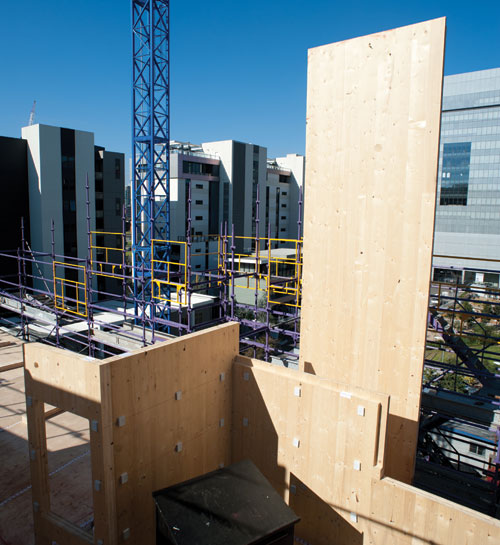Tall Wood Takes a Stand
Building Height Considerations
Engineers must make considerations for shrinkage in tall wood structures, but these accommodations can be easily achieved. Because they use engineered wood products, mass timber buildings have minimal shrinkage over time because the moisture content of the wood used in engineered wood is typically just 8 to 10 percent. Therefore, mass timber products experience little shrinkage along the main axis of the material during the life of a building. Slightly more shrinkage can be found across the thickness of CLT material than with LSL or LVL due to CLT's solid wood composition. Therefore, platform-based CLT construction can result in slightly more accumulative shrinkage over the height of the building than systems that rely more heavily on LVL or LSL, requiring additional consideration in the detailing of the exterior envelope. Balloon-frame FFTT-type designs which use the length of the mass timber panels experience slightly less shrinkage. Shrinkage is not a problem in the LCT system because of the use of manufactured wood products, which have a low moisture content, and because the column-to-column loads are transferred through metal plates into the concrete section of the edge beams of the slabs.
Wood-frame structures can also shorten vertically due to loading, so designers must include design considerations to accommodate this, particularly as the buildings get taller. Possible solutions include the use of a continuous rod tie-down system with a shrinkage compensation device to limit deflection and avoid wall separation under wind and seismic forces. Designers can also include expansion joints in the cladding and provisions in the mechanical systems to allow for movement. There are many design support materials that help simplify these calculations for tall wood buildings.
 |
The 10-story Forté project in Melbourne, Australia used a conventional platform-based CLT system. Photo courtesy of Lend Lease |
Code Approvals
Code-allowed height for combustible buildings varies around the world. Currently, U.S. and Canadian building codes do not explicitly recognize mass timber systems, but this does not prohibit their use under alternative method provisions. In the next edition of the IBC, recently approved changes will streamline the acceptance of CLT buildings. In May 2012, APA published ANSI/APA PRG 320-2011 Standard for Performance-Rated Cross-Laminated Timber, which details manufacturing and performance requirements for qualification and quality assurance. The 2015 edition of the IBC will recognize CLT products when they are manufactured according to the standard. CLT walls and floors will be permitted in all types of combustible construction, including use as exterior bearing walls in Type IV buildings. One of the primary challenges facing tall wood designers is the fact that residential buildings over six stories in height (and exceeding a certain total building area) are required to be of non-combustible construction, so gaining access to this market will require well-proven fire performance. Fire resistance testing confirmed that CLT exterior walls exceed the requirements for heavy timber construction. Because CLT construction typically eliminates concealed spaces, this enhances its ability to meet Type IV construction requirements.
As with all new products that enter the market, local building code officials will give their approval providing safety and performance can be proven—as was the case with the Long Hall project in Whitefish, Montana, an all-CLT system. Although the project was just two stories, local code officials were not familiar with CLT, and project engineer Darryl Byle of CLT Solutions says it was critical to plan ahead to improve their familiarity with the system. Byle negotiated to reduce the required overall thickness of the wall assembly by taking advantage of CLT's unique structural characteristics. Because the CLT was only exposed on one side, it could easily achieve the code-prescribed one-hour fire resistance requirement. Further, he demonstrated that the undamaged portion could still transfer loads bi-directionally around the compromised area. Byle established a reasonable fire event dimension and designed the structure to deal with that localized structural compromise (an approach that is conceptually similar to disproportionate collapse regulations used in the United Kingdom).
Cree Buildings, Inc. is currently working with ARUP, a global engineering firm, to adapt their LCT design to meet California seismic and fire code requirements. Tahan says the char rate of wood allows 1-1/2-inch thickness for every hour of protection needed, and columns in the LCT system are interrupted by the hybrid slabs for additional fire protection.









